
The Bottom Line
Introduction and Specifications
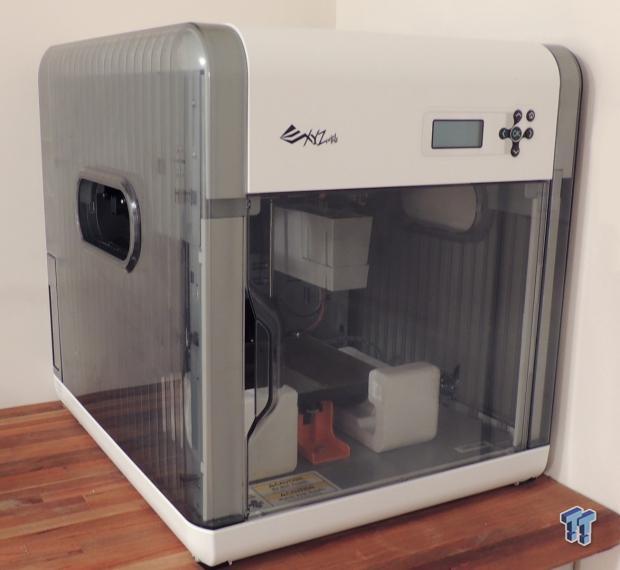
I have a dream - a dream that one day I will be able to make whatever object I want. That day isn't here yet; however, the day has come where I can make whatever object I want out of plastic. The technology we have to thank for this ability to print solid objects is called "fuse filament fabrication," a seemingly simple process in which thin layers of material are placed on top of one another to create an object. This technology has been around for decades, but the advent of low-cost silicon, paired with an ever growing electronic hobby movement, has led to a world where anyone with a few hundred bucks burning a hole in their pocket can bring home a device capable of printing in three dimensions.
3D printers have become mainstream; you can even walk into a few stores like Microcenter or Home Depot and take one home the very same day, which is exactly what I did. However, the selection process and research was more exhaustive than it should have been because there was a lack of what I like to call "full standardized reviews." This led me on a long, yet enlightening journey through the blog and forum scene for 3D printers, and I finally made my purchase decision. I drove home with my Da Vinci 1.0 about three months ago, and since then I have put together what I think is a good standardized review structure for 3D printers. So, grab some popcorn, because this is going to be interesting.
Specifications
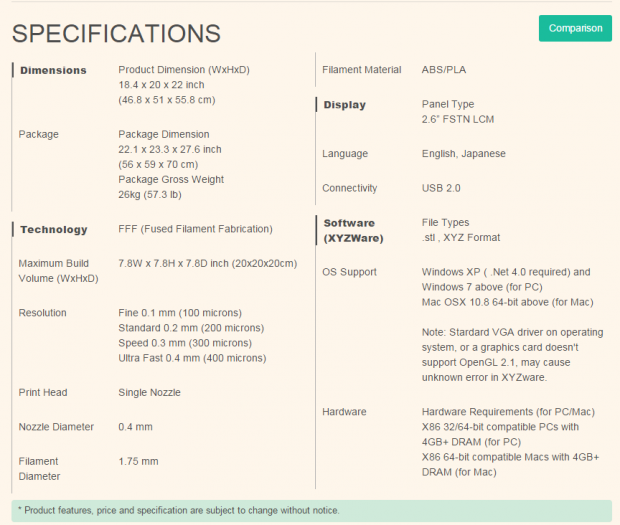
At $500 USD, the XYZprinting Da Vinci 1.0 is aggressively priced, and offers an impressive list of specifications for its price. Like most 3D printers in the sub-$1000 range, the Da Vinci 1.0 can print down to a resolution of 100 microns, which is 0.1mm. The Da Vinci 1.0 also has a large print bed in comparison to other printers, and even some printers above the $1000 mark. At 7.8 x 7.8 x 7.8 inches (20cm =7.8inches), it can't print you an entire fake arm in one go, but it can print one in three to four smaller segments.
When we get to material, ABS is supported and it is my preferred printing material. What is interesting is that XYZprinting lists the Da Vinci 1.0 as PLA capable; however, I don't believe that is possible unless you hack the printer to turn off its bed heating, and bypass the proprietary filament requirements.
PRICING: You can find the XYZprinting Da Vinci 1.0 3D printer for sale below. The prices listed are valid at the time of writing, but can change at any time. Click the link to see the very latest pricing for the best deal.
United States: The Da Vinci 1.0 retails for $499.99 at Amazon.
Packaging and Accessories
Since most people order their 3D printers online, packaging is quite important.
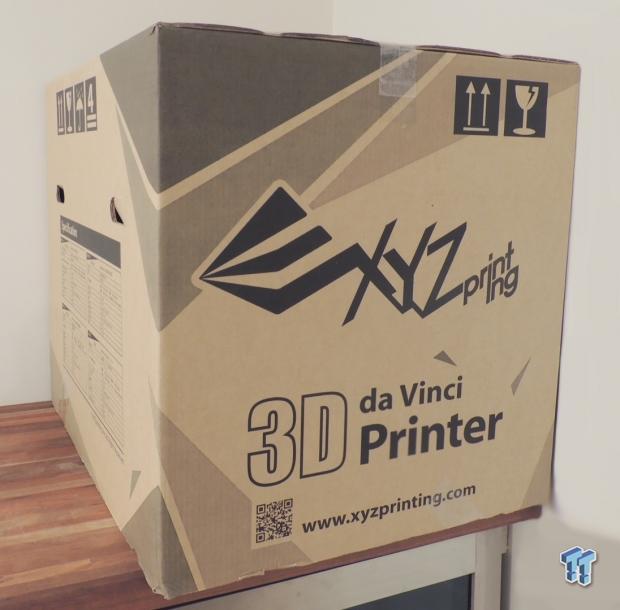
There were actually four heavy-duty plastic straps that encircled the box, but I was in such a hurry to open the package that I neglected to take a picture before I cut them off.
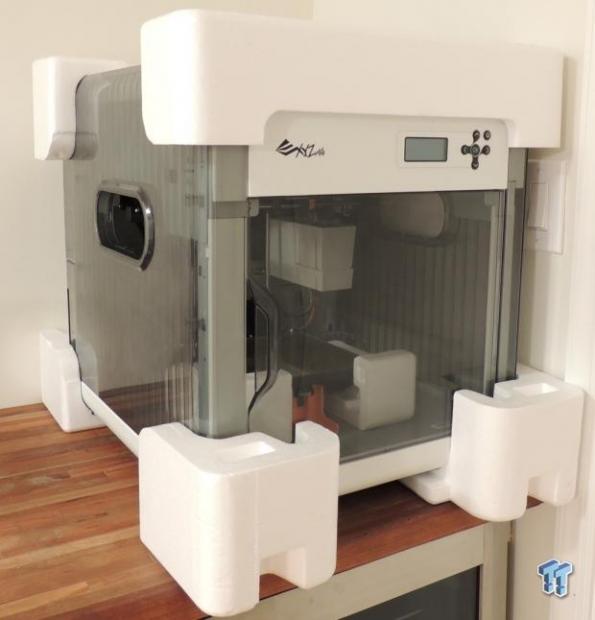
XYZprinting did a good job of providing adequate protection; there is a lot of Styrofoam keeping the printer safe from damage. These printers cost a lot to ship, so I am sure better packaging benefits manufacturers and retailers more than consumers.
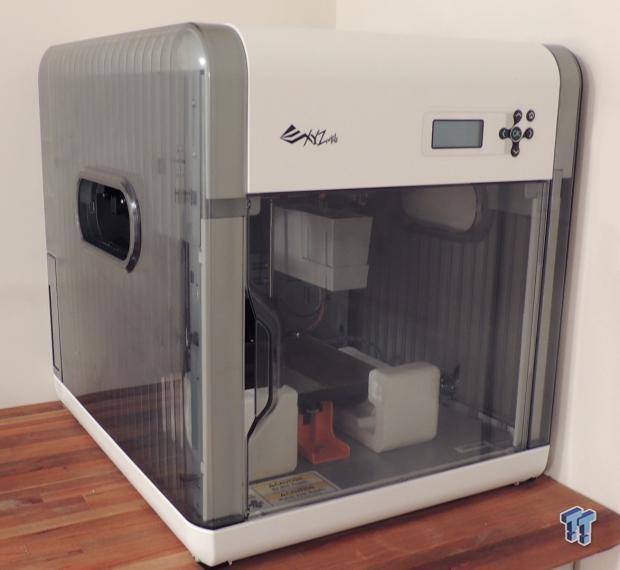
All parts are intact, and the Da Vinci 1.0 is basically ready to go out of the box. The protection that the exterior chassis provides is great; it prevents people from sticking their hands in there, and this is especially important when the extruder is at 212C, and the print bed at 90C. The body also provides insulation, both from the smell of the melted plastic, and the heat the printer creates. However, one of the joys of 3D printing is watching the printer work, and this printer gives viewers great vantage points.
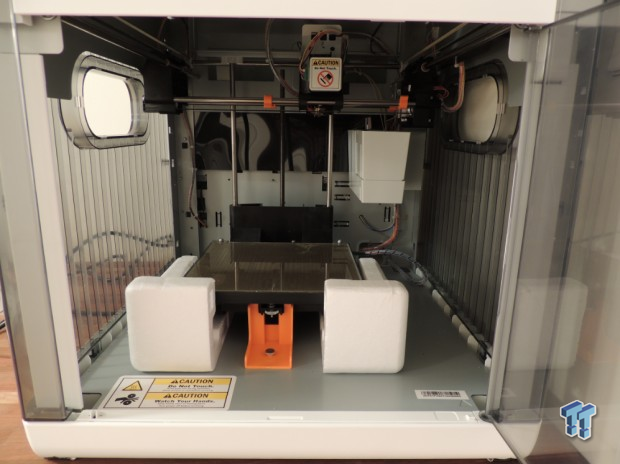
The print bed is secured to the base of the body with a thumb screw, and Styrofoam supports keep it in place so the factory calibration of the print bed isn't screwed up. XYZprinting actually suggests that users do not attempt to calibrate the printer, and I didn't have to at all. The rails that the extruder is attached to were also supported by plastic pieces; you will remove these plastic bits before use.
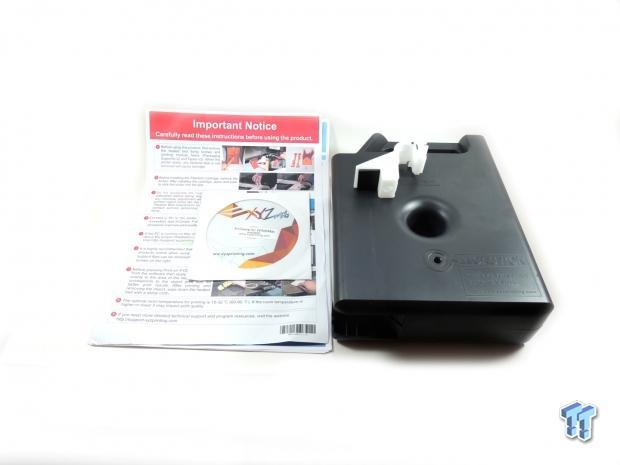
Along with the printer, this package includes a user manual, quick guide, and driver disc. The package also comes with a complimentary, white filament, sample cartridge. One downside everyone likes to bring up with XYZprinting printers is that if you don't want to hack the printer, you will have to buy their proprietary cartridges. They are a tad more expensive at $28 for 600grams (240m); normally, you can get 1kg for the same price. However, there is a benefit to the proprietary cartridge. The proprietary cartridge has a chip that records how much filament has been used. You can access that information through the printer's panel, and it's great if you want to easily estimate or check how much filament you want to use.

The Da Vinci 1.0 comes with all of the accessories you see above. I was impressed with their accessories. While it may not look like much, XYZprinting gives you almost everything you need to get started with printing. The brass brush is for cleaning the extruder head, the scraper is for getting prints off the base, the glue stick is for prepping the base for hard to print objects, and the little rings are for inserting into the extruder nozzle (I haven't had to use them yet).
The Printer, Inside and Out
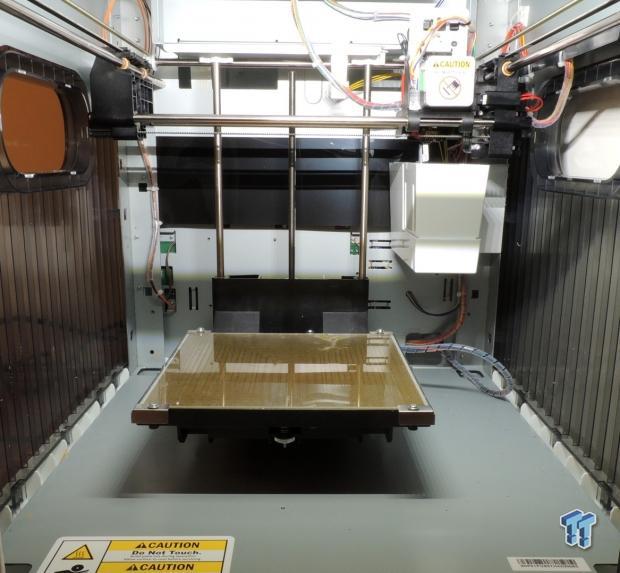
I have always been a big fan of mechanical hardware, and I would imagine that building a device that prints at the micron level would leave little room for deviation. You basically need as close to perfection as possible, and that is why these devices cost a lot. The parts are readily available, it's putting them together correctly and with precision that is difficult.
The fact of the matter is that the Da Vinci 1.0 is very well built. Every time I hit calibration over the course of three months, the printer was on target, and I had never calibrated it. The majority of my prints come out excellent if I prep the base correctly, and ensure the extruder nozzle is clean. Everything from the wire lengths to timing belts appear to have been standardized; I was thoroughly impressed by the details of the Da Vinci 1.0's construction. The extruder even has its own cleaning system.
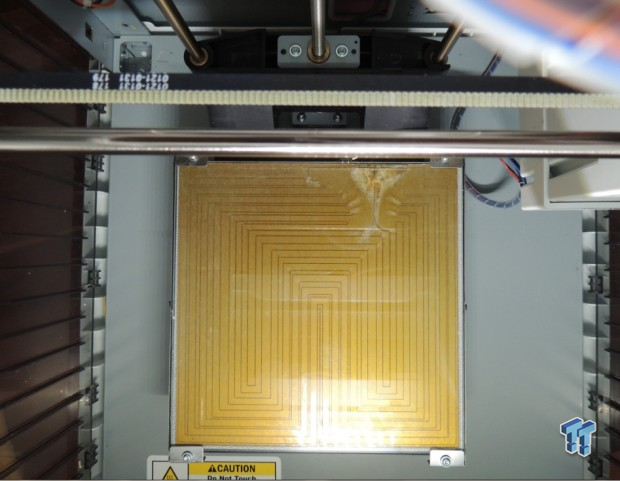
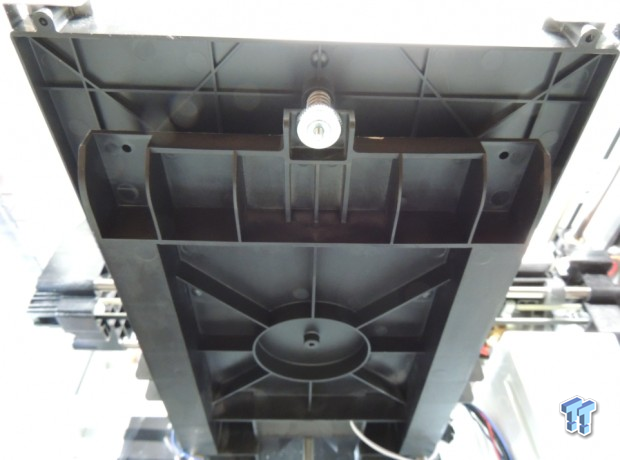
This is the heated print platform, you can see that the heater element is glued to the glass bed; mine looks like it has some problem near the top, but it works fine - it's just a small amount of glue that set like that. The underside of the print bed has three thumb screws like the one shown above. These thumbscrews are used for calibration.
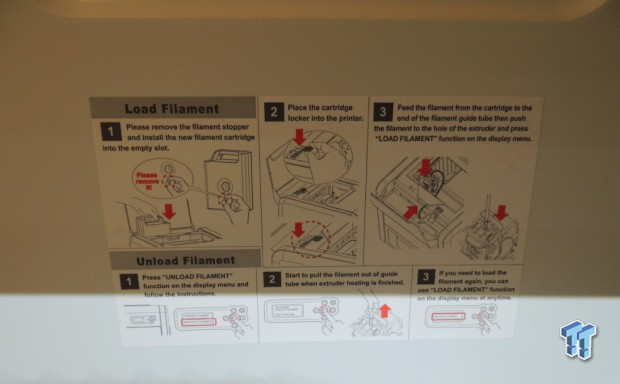
This printer was made so even a child could operate it. There are well written directions on how to do most everything, including changing the cartridge. Using a 3D printer for the first time can be a scary thought, but this printer makes it simple.
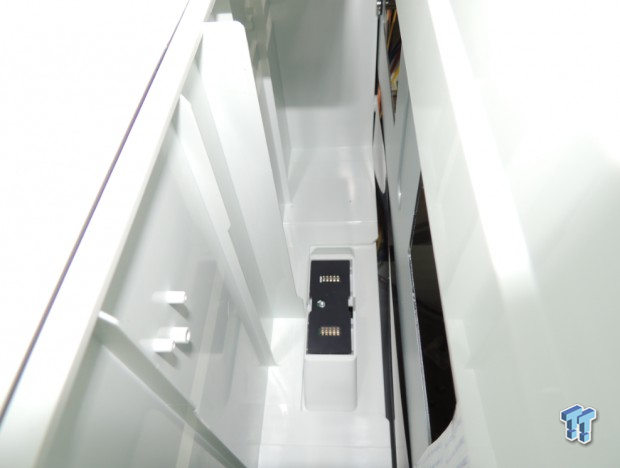
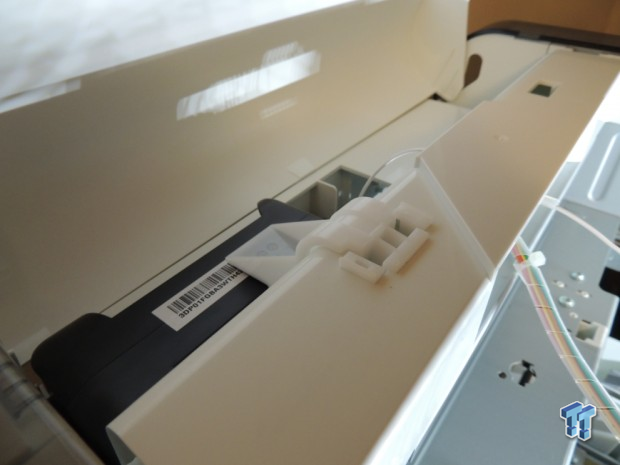
This space with contact pads is for the cartridge. There are times when I look at this printer and think it was designed for the dual extruder model (the Da Vinci 2.0). There is room for a second cartridge, and the circuit board has empty pads that appear to be for a second extruder, so I would think that a user could convert it themselves.

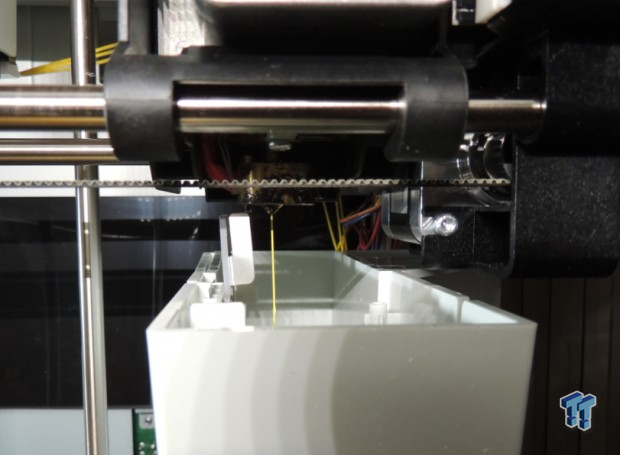
I had used this printer before I took these pictures. The reason I mention this is because the extruder nozzle is covered in residue from the many prints I have done, and otherwise, it is a shiny brass color. The extruder, just like many other parts of printer, is built to be disassembled for maintenance or repair.
Loading the filament is very easy, and there is a latch to pull back part of the wheel that feeds it in for easier insertion. The extruder sits above a drip box for filament. The extruder will ooze filament when you install it, and this box catches that oozed filament. There is even a mode to allow you to remove the drip box and clean it out.
The box does have another feature; two little flaps (one metal and one plastic) sit at the top near the nozzle head, and the extruder will move itself (and the nozzle) into the flaps in either direction to clean the head and prepare to print. This is quite a nice feature, and I did not see a similar feature in other printers of this price range.
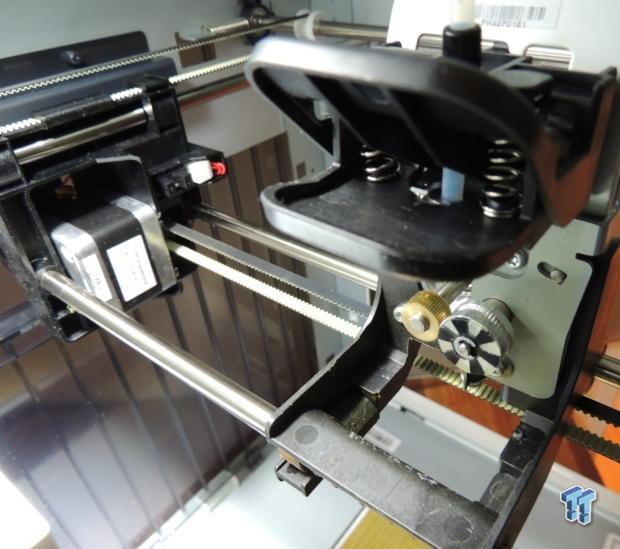
Removing the extruder hardware and nozzle is very simple; just press down on a huge latch, and unplug a few wires.
A 3D printer needs a total of four motors to function. It needs one for each axis (X, Y, and Z), as well as one to push filament through the nozzle. You can see that system here. The filament is pushed down into the nozzle by the two wheels. After three months of use, the wheels are still very clean.
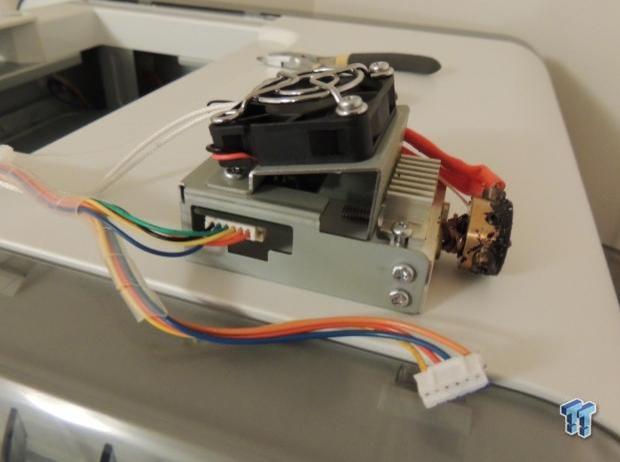
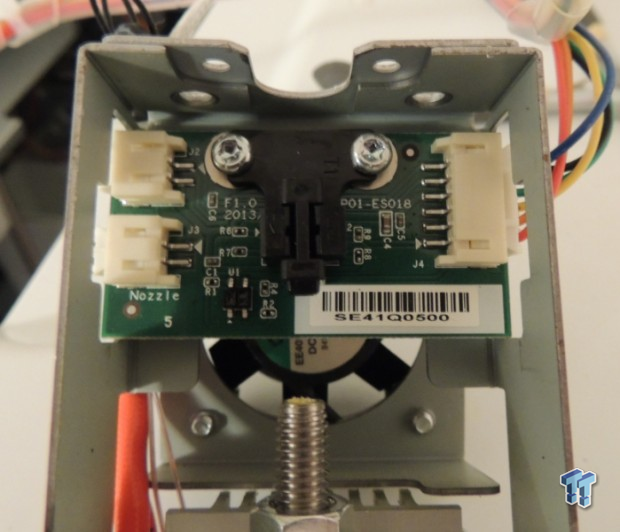
There is a small fan to cool down the nozzle, which gets to 212C for printing. You can also see how dirty the nozzle is after three months of use. It is better to clean the nozzle with the brass brush and rubbing alcohol (if needed) as you go. After print residue dries, it is very hard to clean; however, the printer offers a cleaning mode where it only heats up the nozzle head for cleaning.
This is the circuit inside the extruder that monitors the filament right before it goes into the nozzle.
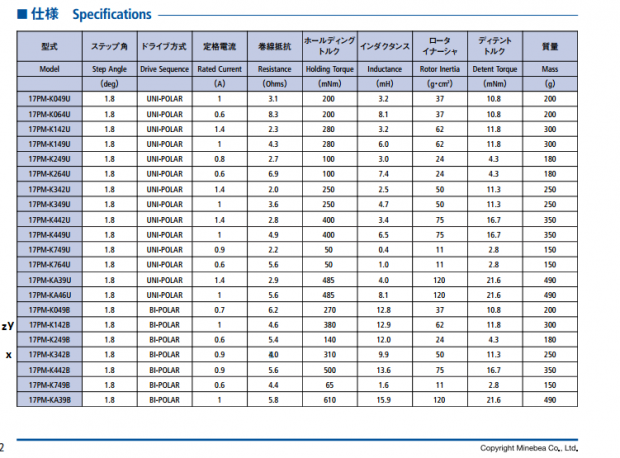
These are the specifications of the bi-polar hybrid step motors used in the printer. They are made by Minebea, and are of pretty good quality. They are also widely available in case you need a replacement.
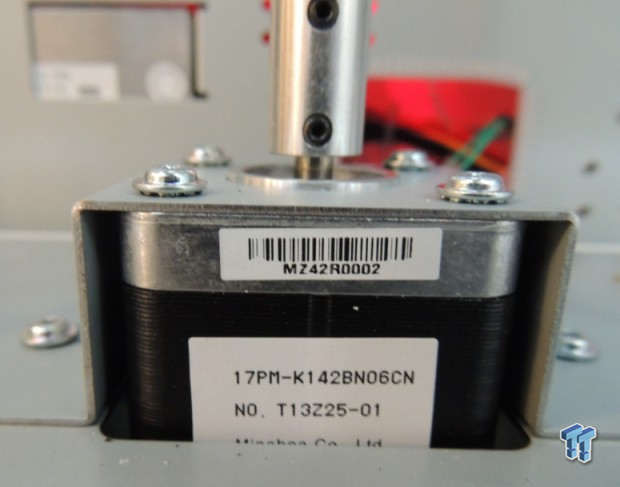
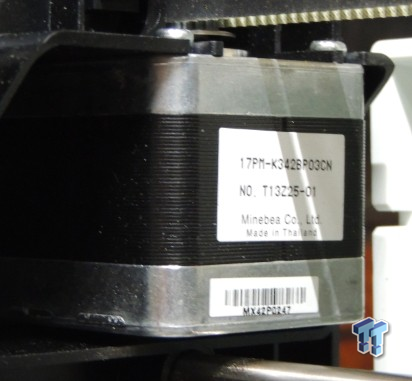
The Z-axis uses the 17PM-K142BN06CN, and the X and Y-axis both use the 17PM-K342BP03CN.
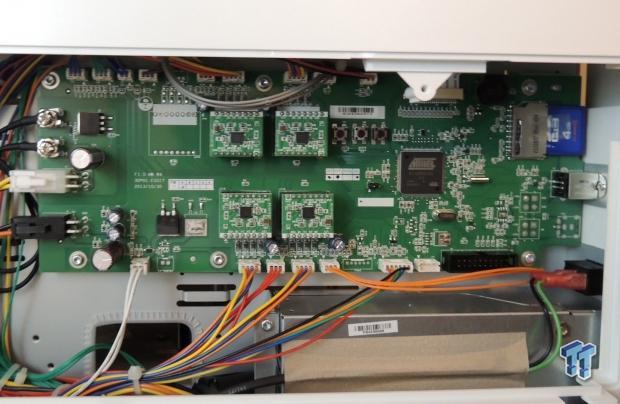
By removing two screws, you can access the circuitry that runs everything. All of the connectors are colored differently, so if you plan on removing them, you should take a picture to remember where everything goes. What is awesome is that the wires are so well measured and placed that you can literally plug them back into the nearest port.
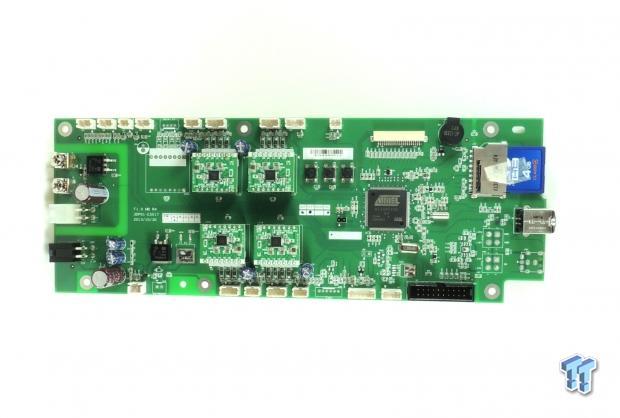
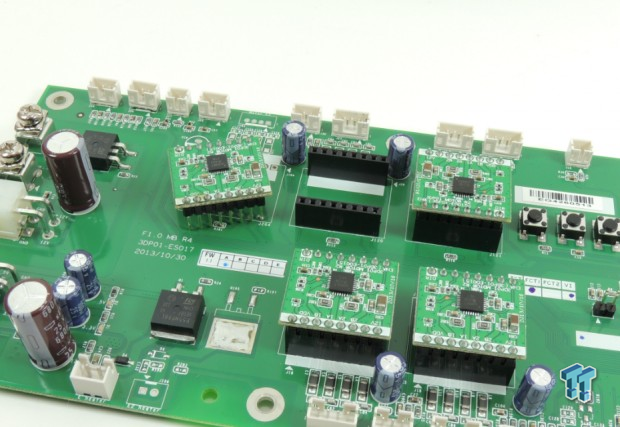
The motherboard only has circuitry on one side. The motor drivers are also modular, and you can see the empty space for a second extruder motor.
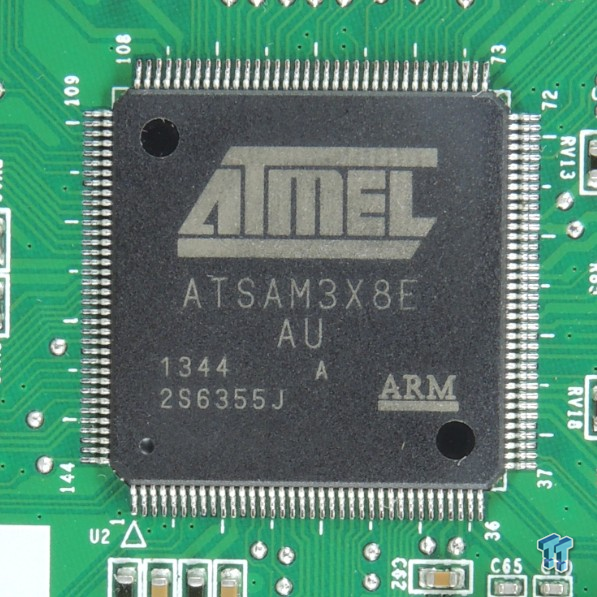
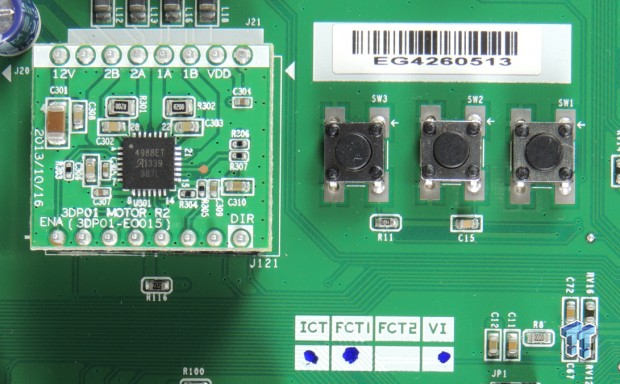
The Amtel ATSAM3X8E-AU is the only chip soldered on the board. It is a pretty powerful ARM Coretex-M3 based SoC. This is basically a powerful little chip that does everything, and it is a common microcontroller found on the Arduino Due. It has a lot of features, runs at only 84MHz, has half a gig of flash, and is the brain of this machine.
Then we have the drivers for the motors. Allegro A4988's control the stepping motors. The driver boards are also easy to source in case you need replacements.
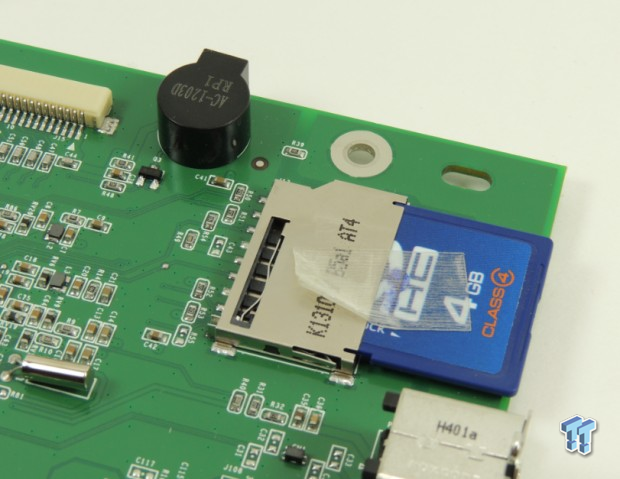
The board has a SD card slot, and the SD card holds the secret to unlocking the Da Vinci. There are three demo prints on the SD card, and it's important to note the first demo print model doesn't count against your filament count. What's better is that the SD card demo print file is in g-code format, so you can turn off the heat bed and print PLA. You can just replace the g-code in the sample file with your own, and use whatever filament and program you want. This backdoor allows you to use this printer as if it were open source.
There is a drawback to this method. The SD card is very hard to remove without removing the entire board, which the majority of users won't do. Personally, I like the added convenience of knowing how much more I can print with the counter built into the cartridges, so I haven't attempted this yet.
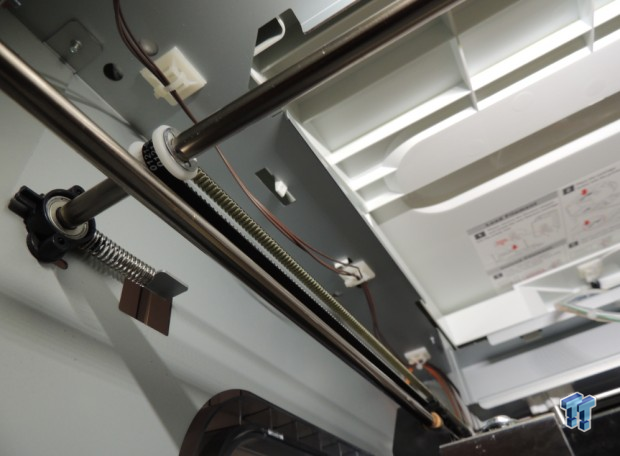
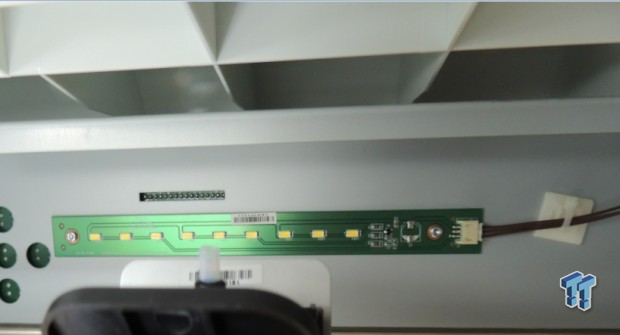
I just wanted to take a picture to show the bearings, timing belt, and the quality, which is pretty good. You can also see how the wiring is well done throughout the body. The printer is very well lit inside the body, and you can see the LEDs responsible are well hidden. XYZprinting has done a good job of making this printer easy to service, so you probably will never have to ship the printer to them if something breaks, since they could ship you the part and tell you how to install it.
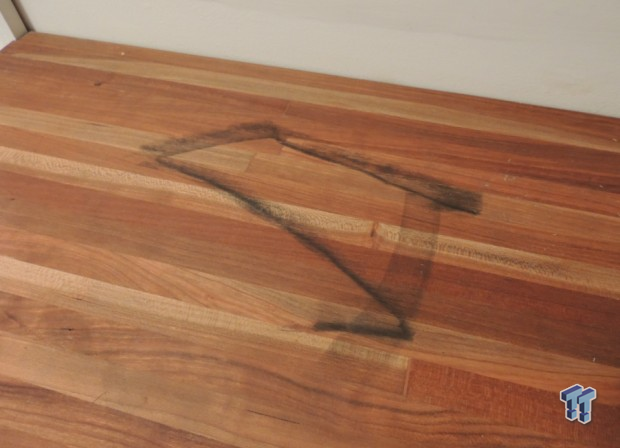
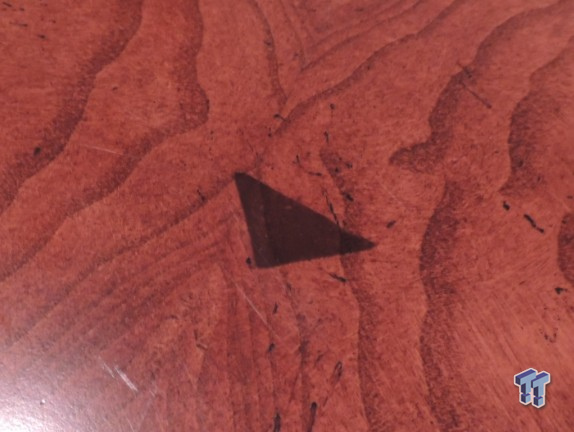
While the feet do need to be slide resistant, they shouldn't marks like they did on two different wooden tables. The mark basically seeps into the surface. In the end, I just took some Gorilla tape and covered the feet, and now the printer works fine, doesn't move, and doesn't make a mark I can't remove.
Printer Display and Software
Printer Display

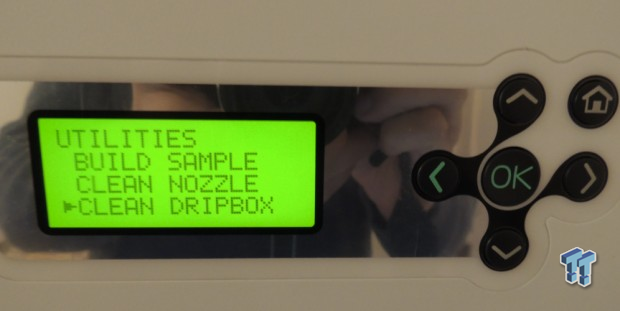
The printer has a small, backlit, monochromatic, LCD display that allows you to control the printer. You can even print a demo without hooking the printer up to a computer. When the printer gets ready to print, it shows the temperatures of the extruder and platform. There are many things you can do through the menu, like go into the utilities to build a sample, or perform maintenance.
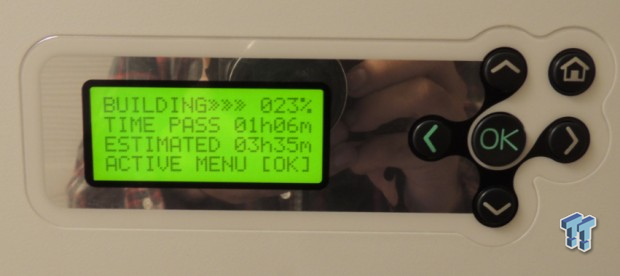
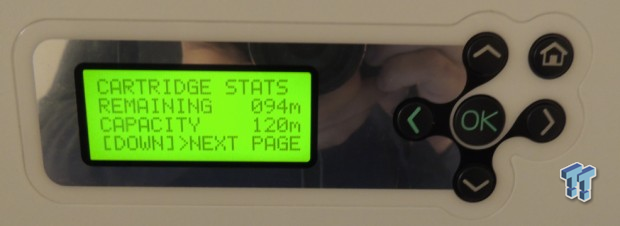
When the printer is printing, it shows the amount of time that has passed, the estimated time left, and how much of the print is complete. You can also check the statistics of the cartridge. The stock cartridge is 120m, but the ones you buy afterward are 240m (600grams).
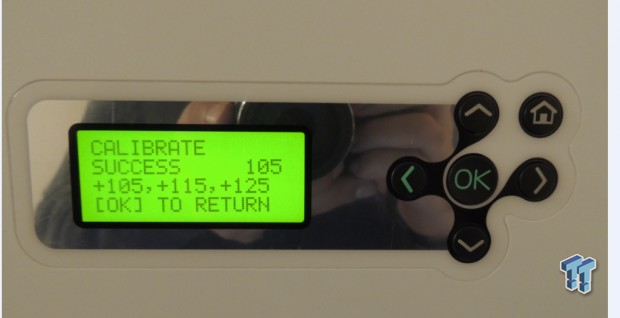
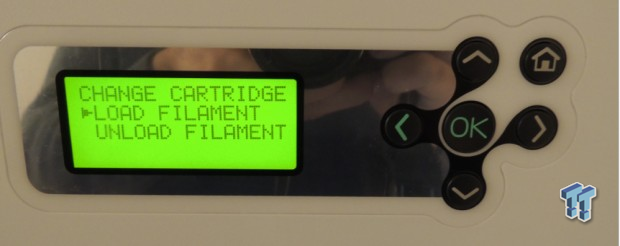
I actually decided to fiddle with the calibration. I didn't need to, but for the review, I decided to venture into every aspect of the printer. As long as the values are within 20mm of each other, it passes as a success.
You can also load the cartridge and unload it. The motor will actually push out the filament when unloading, which some other printers fail to do.
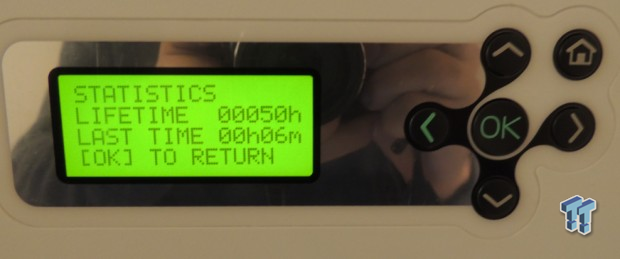
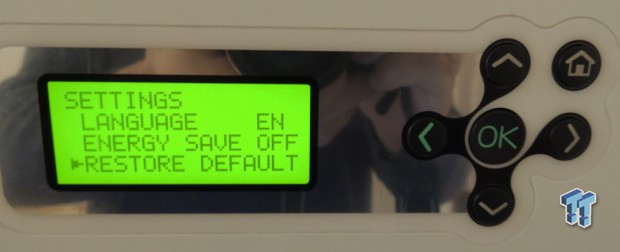
The printer shows lifetime statistics, but I think they are only measured from the time of the last firmware update. If you screw things up, you can always hit the "restore default" option in the menu.
Software
The Da Vinci uses proprietary software named "XYZware." This software uses the standard .STL format, and you can download STL files from many sites around the web. I do recommend you use a free service from Microsoft to "fix" some complicated models. You can find that service here. The software is kind of basic, so it doesn't give the user total control of everything, but it's very easy to use, and provides a decent feature set.

Just double-click a STL file on your computer, and the software opens up. To place more than one object on the bed, you simply click "import," select the next STL file, and the software positions all objects automatically. Each of the objects in the image above was a separate STL file. In the software, you can manually position the objects, and change their size by percentages. After the software slices the object (change the object from computer code to 3D printer hardware code), and transmits the design to the printer, you can disconnect the computer.
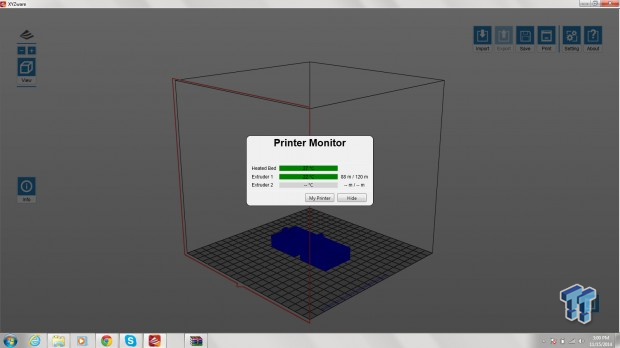
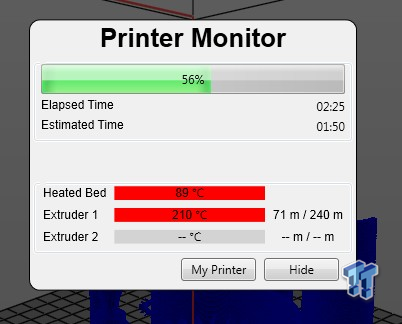
The software has a real-time connection with the printer, and you can view the printer's stats while it is idling, or while it is printing. The software gives roughly the same time estimates as the printer display.
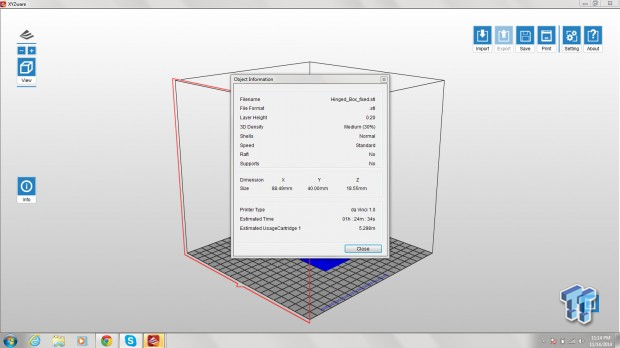
While the object is printing, you can access some basic information on it.
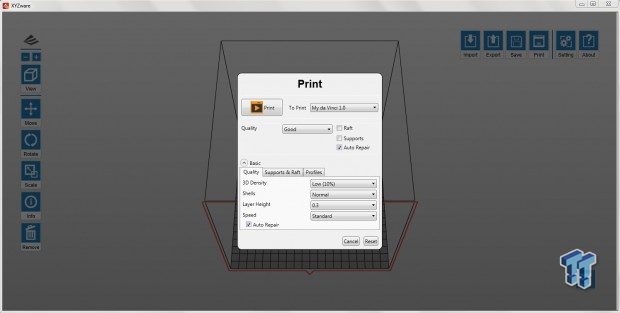
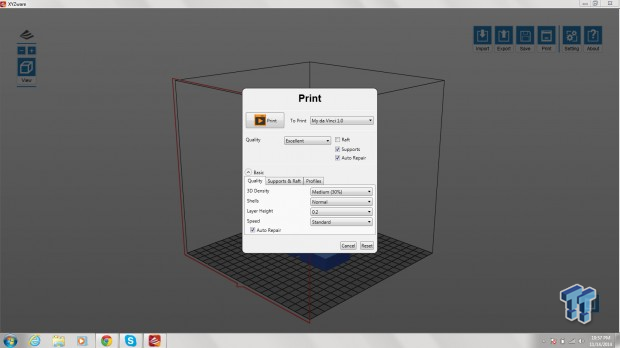
Before you print, you can specify the quality, and other aspects of the print. The standard quality is good, but I usually use excellent. The software gives you the ability to change everything from speed to layer height to 3D density. You can even add rafts and supports for hard to print objects; however, the customization of rafts and supports is limited.
Printer Operation and Testing
For testing the printer, I picked a challenging model from GE, as well as a 3D object testing template that will push the printer to its limits.
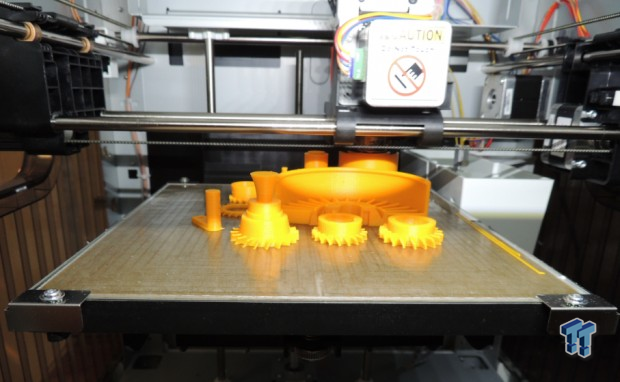
First, I wanted to show off a print that came out excellent the first time. The GE Build Your Own Jet Engine is a series of 14 STL files that produces parts for a model GE jet engine.

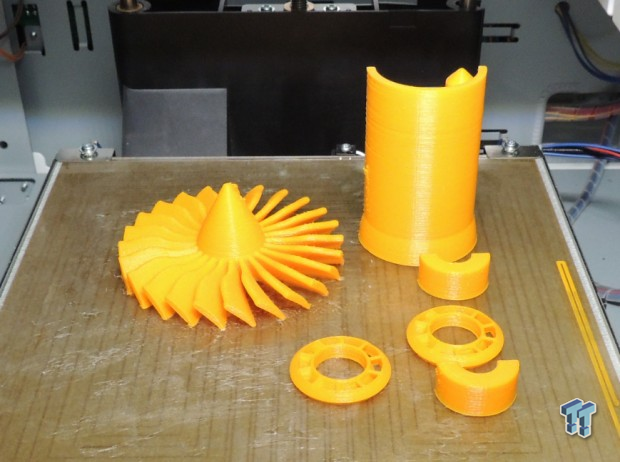
Not all of the pieces could fit on the bed. The total print time was around 18 hours.
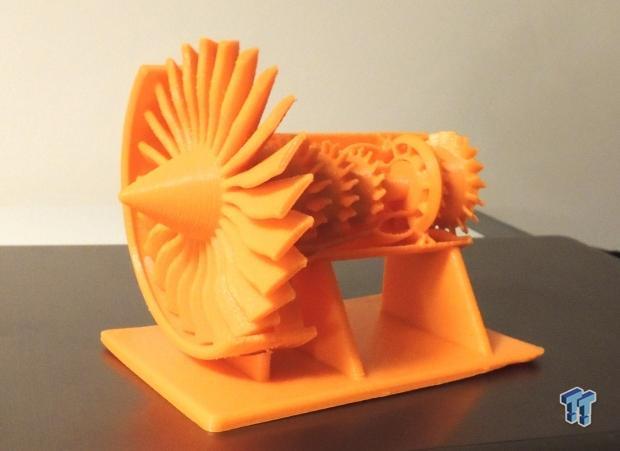
The finished product came out really great, with the exception of the base that didn't fully stick to the platform because I didn't clean and re-apply the glue stick. I didn't sand anything down, and I didn't polish the model; I only used some acetone to melt some pieces together in lieu of glue.
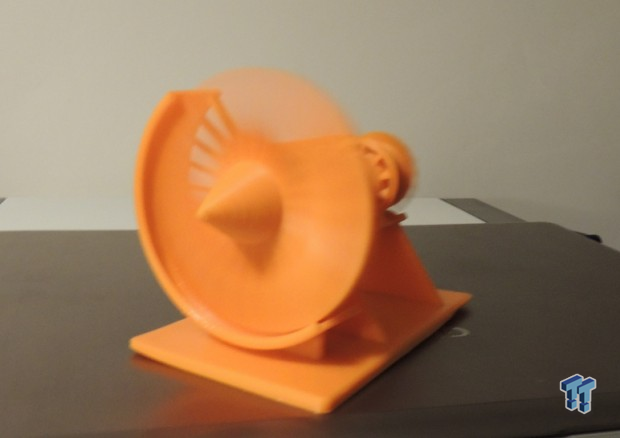
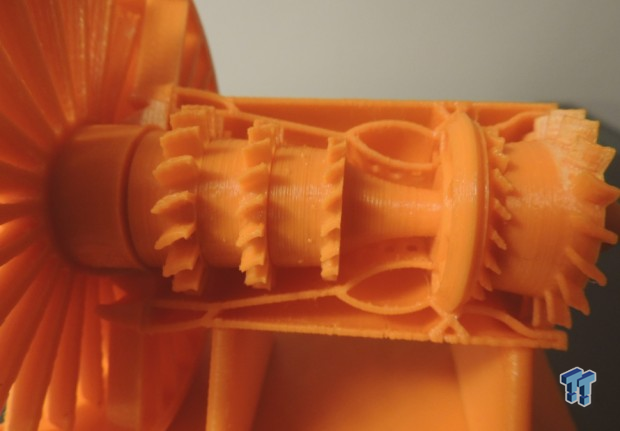
All of the pieces came together with precision, and it spins freely. I printed this at 0.2mm resolution; you will see the difference between 0.1mm and 0.2mm below with our very hard test print.
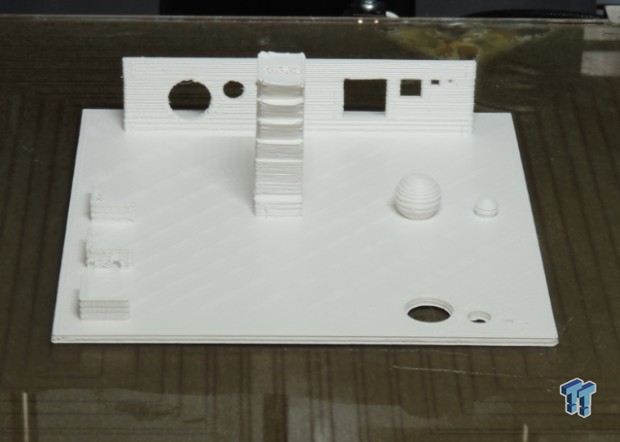
This is the 0.2mm test print, and you can see that I didn't use any rafts or supports, which is why the overhang doesn't have a nice top section. This print takes about 2.5 hours to complete. It prints three walls with different thicknesses, circular holes, balls, overhangs, and a wall with voids. Nearly everything came out very well, with the exception of the overhang print at the top, and the single layer middle wall.
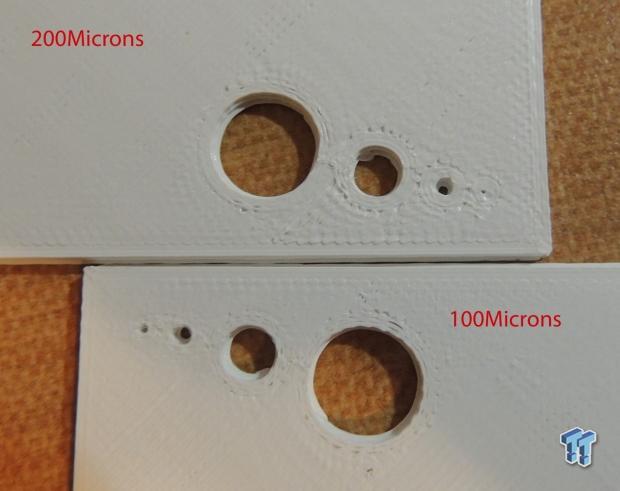
I printed this test print twice, once at 0.2mm, and again at 0.1mm to see the difference. The resolution at 0.1mm is much better; here you can see all four holes, while on the 0.2mm you can barely see the tiniest.
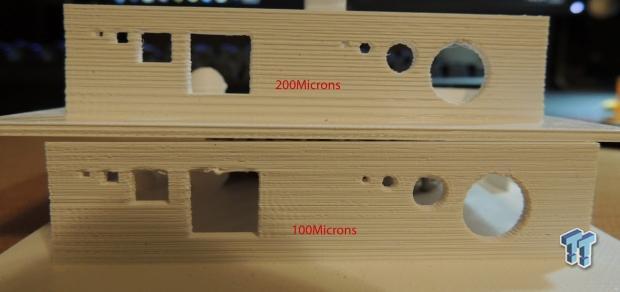
While there will always be layering, it is less noticeable with the 0.1mm. However, the overhangs are a bit better at 0.2mm since the layer is a bit thicker.
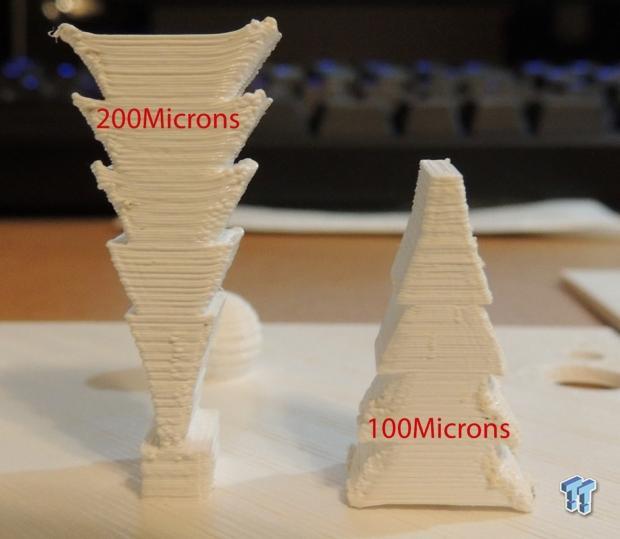
The 0.2mm print overhang screws up towards the top since I didn't add any supports. I accidently broke off the top of the 0.1mm, and I had to cancel the print before it printed its 5th overhang.
PSA: Don't stick your hand in there while the printer is on to see if it's sturdy.
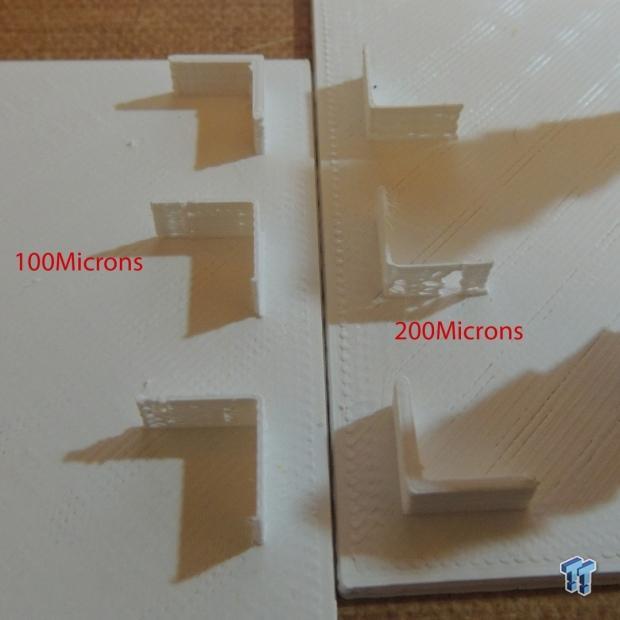
The difference is negligible between the thicker walls in 0.1mm and 0.2mm; however, the thinner walls are much better at 0.1mm. I don't think you will ever print single layer walls like the middle wall in the picture.
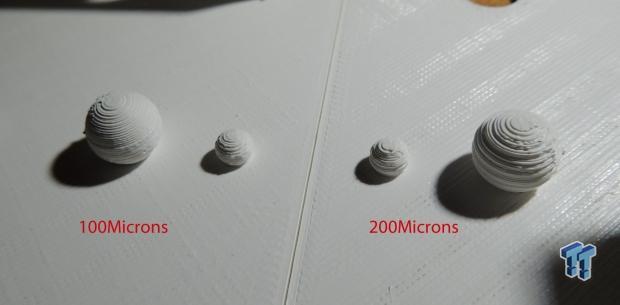
The ball is really where the difference between 0.1mm and 0.2mm is apparent; the resolution at 0.1mm really helps with making a nice ball.
Final Thoughts
The whole notion of a device that prints objects might seem complicated to any novice who wants to get into 3D printing; however, the Da Vinci 1.0 really makes setup and operation as simple as possible. The Da Vinci 1.0 comes pre built, pre-calibrated, and only needs to be plugged into the wall to start printing. Directions are provided for everything from replacing the filament to calibrating the platform, and they are so simple I would say a tech savvy ten-year-old could operate the printer.
The Da Vinci 1.0 is also very solid; the printer's simple, straightforward design makes it a good contender for reliability and longevity. All of the parts it uses were easily locatable on the web, and if you ever need to replace something it should be quite simple to source the part on your own. The one big downside is its use of proprietary cartridge and software, but there are many ways around that if you want to hack the machine.
If you prefer not to hack the printer, there are some benefits to using the cartridge. For example, the counter is a nice feature that lets you know how much filament will be used, so it would be easy to calculate the cost if you wanted to sell something you printed. I also thought the bundled software was pretty good for a $499 printer. The product has been out for a while now, and XYZprinting seems to have straightened out many of the bugs I read about before buying the printer.

The GE jet engine model came out really nice, and with a bit of polishing and sanding, it could look even better, but it isn't hard on the eyes as it is. The test print came out pretty nice, and I was surprised at some of the things the Da Vinci can print without issue. 3D printing isn't always perfect, sometimes prints go bad, but I found that as long as I prepped the bed correctly with the glue stick, my prints came out well without issue.
I have used this printer exclusively for three months now, and from my previous experience with 3D printers, I will say that the one thing the Da Vinci isn't up to par with is printing speed. It will print most everything well, but it will do it a bit slower than other printers. When I was looking to buy a printer, I was surprised at the size of the platform on the Da Vinci supplies. The platform is quite large for the price of the printer.

I have heard some say that if the Da Vinci was open source like some other printers, it would be almost perfect for its price; however, I don't think XYZprinting could sell this printer for $499 without the attached proprietary filament. What you save in the upfront cost of the printer, you pay for with the cartridge over time, but this model is typical of printers. When you buy a paper printer, you usually end up having to buy ink just for that printer, and I think we will see this model continue as 3D printing becomes more mainstream.
Microcenter carries many colors of the Da Vinci filament, and while it is more expensive, you always get the filament that should work best for your printer. In my opinion, the Da Vinci 1.0 is as close as you can get to an affordable consumer printer. The printer's ease of use, performance, and package easily compete with much more pricey competitors. If you are looking to dabble in the world of 3D printers, and don't want to drop a lot of cash, the Da Vinci 1.0 could be the perfect fit for you.
PRICING: You can find the XYZprinting Da Vinci 1.0 3D printer for sale below. The prices listed are valid at the time of writing, but can change at any time. Click the link to see the very latest pricing for the best deal.
United States: The Da Vinci 1.0 retails for $499.99 at Amazon.
